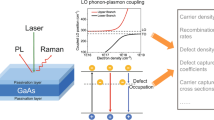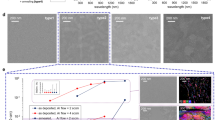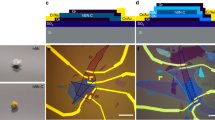Abstract
THE recently developed technique1 of investigating the diffusion of minority carriers in an ambipolar semiconductor has been applied to the study of a twin boundary in germanium. Twinning about a (111) plane readily occurs in crystals having the diamond structure, such as germanium and silicon. A single crystal of n-type germanium, containing one twin boundary, was pulled from the melt by the Czochralski technique. The material used was of reasonably high purity, approximately 5 ohm-cm, resistivity at room temperature. A slice approximately 0.5 mm. thick was cut from this in such a manner that the twinning plane was perpendicular to the surface, which was then ground in the usual manner and etched in C.P.42. The specimen was irradiated with a narrow beam (0.05 mm. wide) of chopped infra-red light, having a wave-length comparable with the width of the forbidden energy gap, 0.72 eV. A probe close to the illuminated spot picks up an electrical signal which corresponds to the change in the Fermi-level or the floating potential under the probe. This change in the potential is proportional to the local density of minority carriers excited across the energy gap by the absorption of the radiation. The drop in signal strength observed as the light spot is gradually moved away from the probe is due to the decay in the number of these carriers. In a single crystal, such decay is caused mainly by recombination of the excess carriers at trapping centres, and a logarithmic plot of signal strength versus distance should give a straight line, the slope of which determines the diffusion distance, closely related to carrier mobility and life-time.
This is a preview of subscription content, access via your institution
Access options
Subscribe to this journal
Receive 51 print issues and online access
$199.00 per year
only $3.90 per issue
Buy this article
- Purchase on SpringerLink
- Instant access to full article PDF
Prices may be subject to local taxes which are calculated during checkout
Similar content being viewed by others
References
Haynes, J. R., and Shockley, W., Phys. Rev., 75, 691 (1949).
Haynes, J. R., and Shockley, W., Phys. Rev., 81, 835 (1951).
Author information
Authors and Affiliations
Rights and permissions
About this article
Cite this article
BILLIG, E., RIDOUT, M. Transmission of Electrons and Holes Across a Twin Boundary in Germanium. Nature 173, 496–497 (1954). https://doi.org/10.1038/173496a0
Issue date:
DOI: https://doi.org/10.1038/173496a0
This article is cited by
-
Plasma-Assisted Synthesis of Bicrystalline ZnS Nanobelts with Enhanced Photocatalytic Ability
Electronic Materials Letters (2020)



